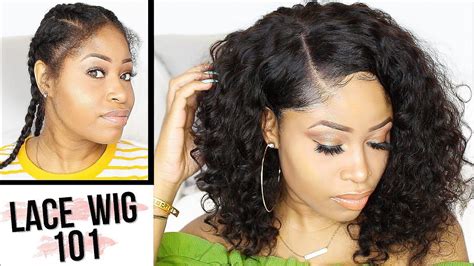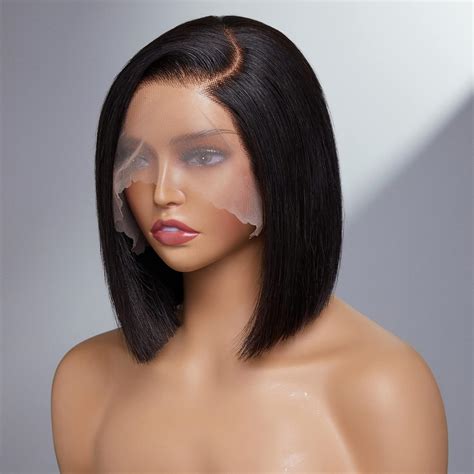Introduction

Wigs have come a long way from their origin as ceremonial or theatrical accessories. Today, wigs are widely used for fashion, hair loss concealment, and personal expression. With the increasing popularity of wigs, the market offers a vast array of options, ranging from synthetic to human hair, lace front to full cap, and every shade and texture imaginable. This guide will provide you with comprehensive information and tips to help you navigate the world of wigs and find the perfect hairpiece that meets your unique needs and desires.
Types of Wigs
1. Synthetic Wigs
- Pros: Affordable, durable, and easy to maintain.
- Cons: Less natural-looking than human hair wigs.
2. Human Hair Wigs
- Pros: Most natural-looking, breathable, and can be styled like your own hair.
- Cons: More expensive and require more maintenance.
3. Lace Front Wigs
- Pros: Create a seamless, natural-looking hairline.
- Cons: Require more skill to apply and maintain.
4. Full Cap Wigs
- Pros: Easy to apply and remove, ideal for beginners.
- Cons: May be less breathable than lace front wigs.
Choosing the Right Wig
1. Determine Your Head Size
Measure the circumference of your head around the hairline to determine your head size. This will ensure that you choose a wig that fits comfortably and securely.
2. Consider Your Face Shape
Different face shapes suit different wig styles. For example, round faces look best with wigs that have bangs or layers, while oval faces can wear most wig styles.
3. Choose the Right Color and Texture
Match the color and texture of the wig to your natural hair as closely as possible. If you’re unsure, consult a professional hairstylist for advice.
4. Decide on the Length
Consider your lifestyle and personal style when choosing the length of your wig. Long wigs require more maintenance, while short wigs are easier to manage.
Common Mistakes to Avoid
1. Choosing a Wig That’s Too Small
A wig that’s too small will be uncomfortable and may cause headaches.
2. Not Wearing a Wig Cap
A wig cap protects your natural hair and helps keep the wig in place.
3. Styling Your Wig Too Aggressively
Synthetic wigs can be damaged by excessive heat or styling.
4. Neglecting Maintenance
Wigs require regular cleaning and conditioning to maintain their appearance and lifespan.
Pros and Cons of Wigs
Pros:
- Conceal hair loss due to medical conditions or treatments.
- Enhance appearance and boost confidence.
- Change your hairstyle without damaging your natural hair.
- Protect your natural hair from damage caused by sun, heat, or chemicals.
Cons:
- Can be expensive, especially human hair wigs.
- Require maintenance, such as cleaning, conditioning, and styling.
- May not be as breathable as natural hair, especially full cap wigs.
Innovative Applications of Wigs
1. Hair Loss Treatment
Wigs are commonly used by individuals experiencing hair loss due to chemotherapy, alopecia, or other medical conditions.
2. Wig Contests
Wig contests have become popular events where wig makers showcase their creativity and craftsmanship.
3. Cosplay
Wigs play a crucial role in cosplay, where individuals transform themselves into their favorite characters.
4. Hair Thinning
Wigs can be used to add volume and fullness to hair that is thinning due to age, genetics, or hormonal changes.
5. Wig Weaving
Wig weaving is a technique that involves incorporating hair extensions into wigs to create unique and custom looks.
Key Statistics on Wigs Industry
- The global wigs and hair extensions market is projected to reach $125.3 billion by 2027, growing at a CAGR of 5.9% from 2022 to 2027.
- Synthetic wigs account for approximately 70% of the wig market.
- The United States is the largest market for wigs, followed by Europe and Asia-Pacific.
- The demand for wigs has increased significantly due to the rise of online shopping and social media.
Conclusion
Wigs have become an indispensable part of the beauty and fashion industry. Whether you’re looking to conceal hair loss, enhance your appearance, or simply experiment with different hairstyles, there’s a wig out there that’s perfect for you. By following the tips and advice provided in this guide, you can confidently navigate the world of wigs and find the hairpiece that best meets your needs and desires.
Additional Resources:
- American Hair Loss Association: https://www.americanhairloss.org/
- International Wigs and Hairpieces Association: https://www.iwha.org/
- Wig Care Tips: https://www.wigs.com/edu/wig-care-tips
Tables:
| Wig Type | Pros | Cons |
|---|---|---|
| Synthetic Wigs | Affordable, durable, easy to maintain | Less natural looking |
| Human Hair Wigs | Natural looking, breathable, can be styled like your own hair | More expensive, require more maintenance |
| Lace Front Wigs | Natural-looking hairline | Require more skill to apply and maintain |
| Full Cap Wigs | Easy to apply and remove | May be less breathable than lace front wigs |
| Head Shape | Suitable Wig Styles |
|---|---|
| Oval | Most wig styles |
| Round | Wigs with bangs or layers |
| Square | Wigs with soft curls or waves |
| Heart | Wigs with side-swept bangs |
| Diamond | Wigs with volume at the crown |
| Wig Length | Considerations |
|---|---|
| Short | Easy to manage, less maintenance |
| Medium | Versatile, suitable for most face shapes |
| Long | Requires more maintenance, may be more difficult to style |
| Wig Maintenance Tips |
|—|—|
| Wash your wig regularly with a shampoo and conditioner specifically designed for wigs. |
| Use a wide-toothed comb or brush to prevent tangles. |
| Avoid using excessive heat when styling your wig. |
| Store your wig on a wig stand or in a breathable bag when not in use.
